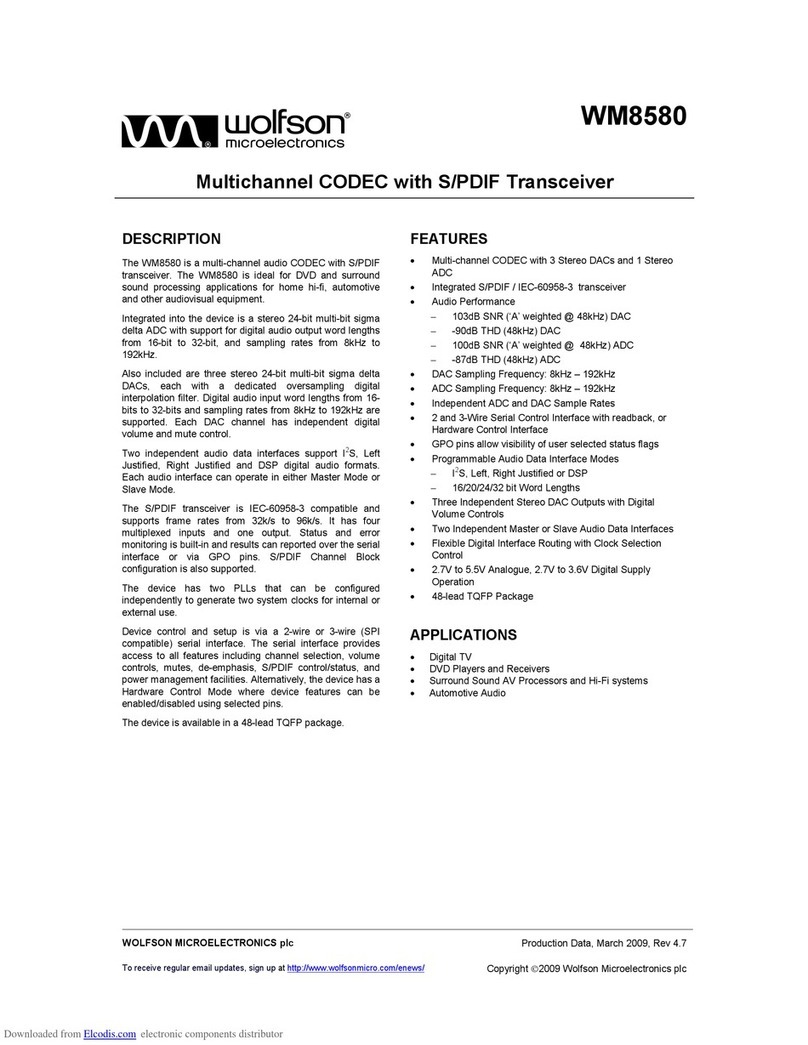
w WM8804
1:1 Digital Interface Transceiver with PLL
WOLFSON MICROELECTRONICS plc
To receive regular email updates, sign up at http://www.wolfsonmicro.com/enews/
Production Data, September 2007, Rev 4.1
Copyright ©2007 Wolfson Microelectronics plc
DESCRIPTION
The WM8804 is a high performance consumer mode
S/PDIF transceiver with support for 1 received channel and
1 transmitted channel.
A crystal derived, or externally provided high quality master
clock is used to allow low jitter recovery of S/PDIF supplied
master clocks.
Generation of all typically used audio clocks is possible
using the high performance internal PLL. A dedicated
CLKOUT pin provides a high drive clock output.
A pass through option is provided which allows the device
simply to be used to clean up (de-jitter) the received digital
audio signals.
The device may be used under software control or stand
alone hardware control modes. In software control mode,
both 2-wire with read back and 3-wire interface modes are
supported.
Status and error monitoring is built-in and results can be
read back over the control interface, on the GPO pins or
streamed over the audio data interface in ‘With Flags’ mode
(audio data with status flags appended).
The audio data interface supports I2S, left justified, right
justified and DSP audio formats of 16-24 bit word length,
with sample rates from 32 to 192ks/s.
The device is supplied in a 20-lead Pb-free SSOP package.
FEATURES
•S/PDIF (IEC60958-3) compliant.
•Advanced jitter attenuating PLL with low intrinsic period
jitter of 50 ps RMS.
•S/PDIF recovered clock using PLL, or stand alone crystal
derived clock generation.
•Supports 10 – 27MHz crystal clock frequencies.
•2-wire / 3-Wire serial or hardware control interface.
•Programmable audio data interface modes:
- I2S, Left, Right Justified or DSP
- 16/20/24 bit word lengths
•1 channel receiver input and 1 channel transmit output.
•Auto frequency detection / synchronisation.
•Selectable output status data bits.
•Up to 3 configurable GPO pins.
•De-emphasis flag output.
•Non-audio detection including DOLBYTM and DTSTM.
•Channel status changed flag.
•Configurable clock distribution with selectable output
MCLK rate of 512fs, 256fs, 128fs and 64fs.
•2.7 to 3.6V digital and PLL supply voltages.
•20-lead SSOP package.
APPLICATIONS
•AV processors and Hi-Fi systems
•Music industry applications
•DVD-P/DVD-RW
•Digital TV
BLOCK DIAGRAM




























